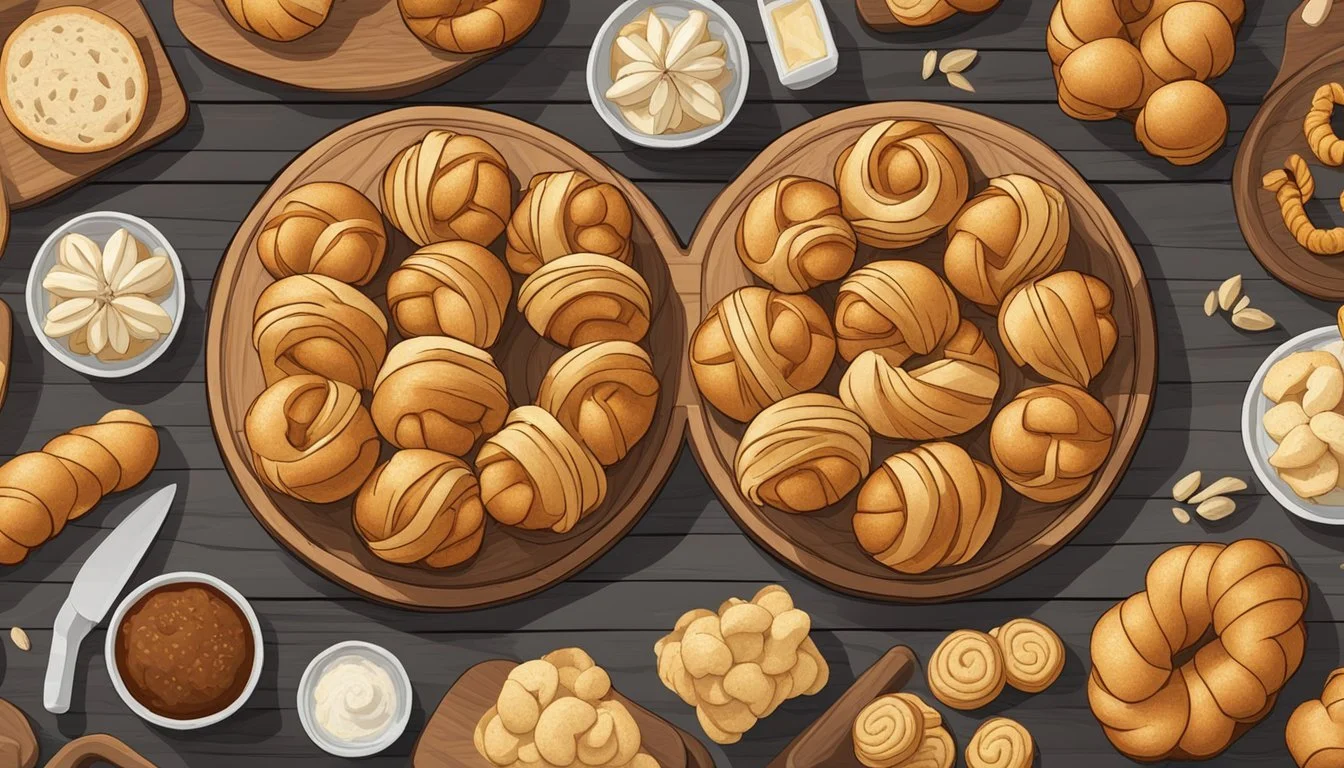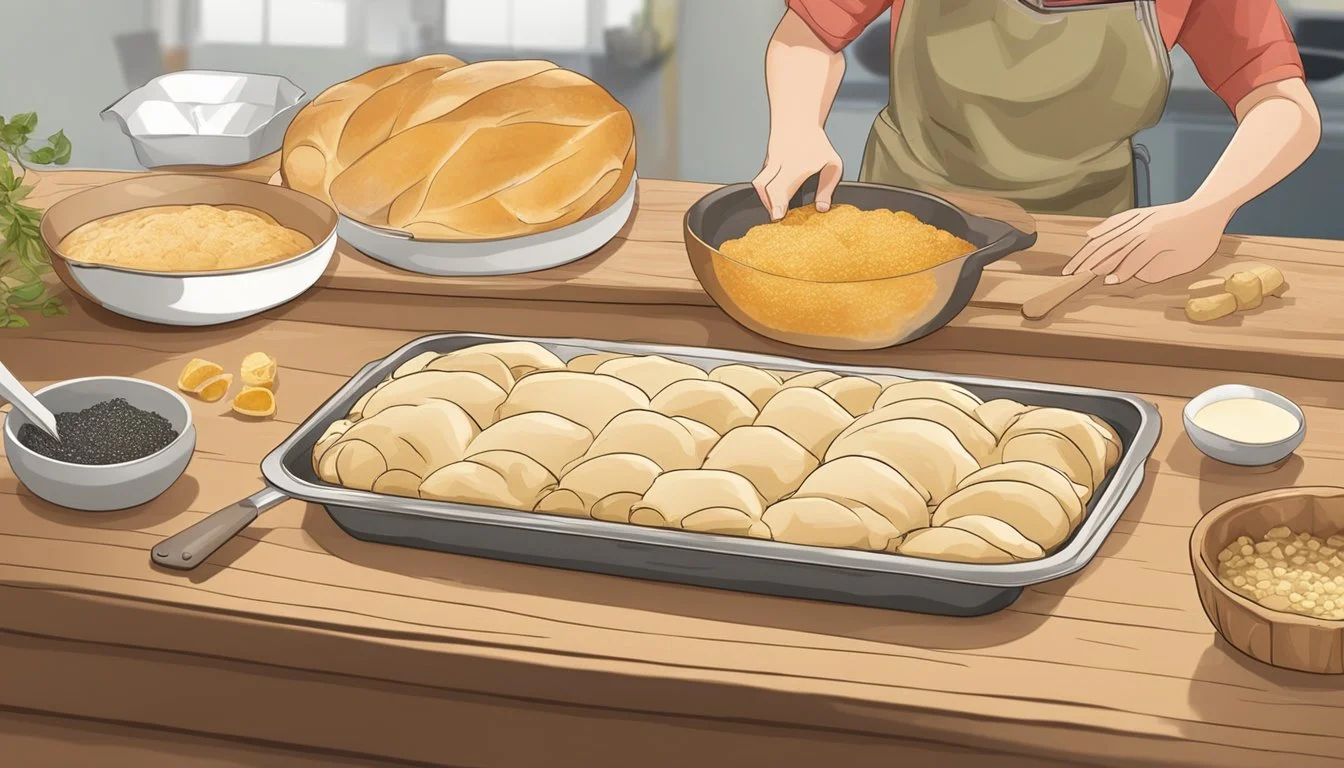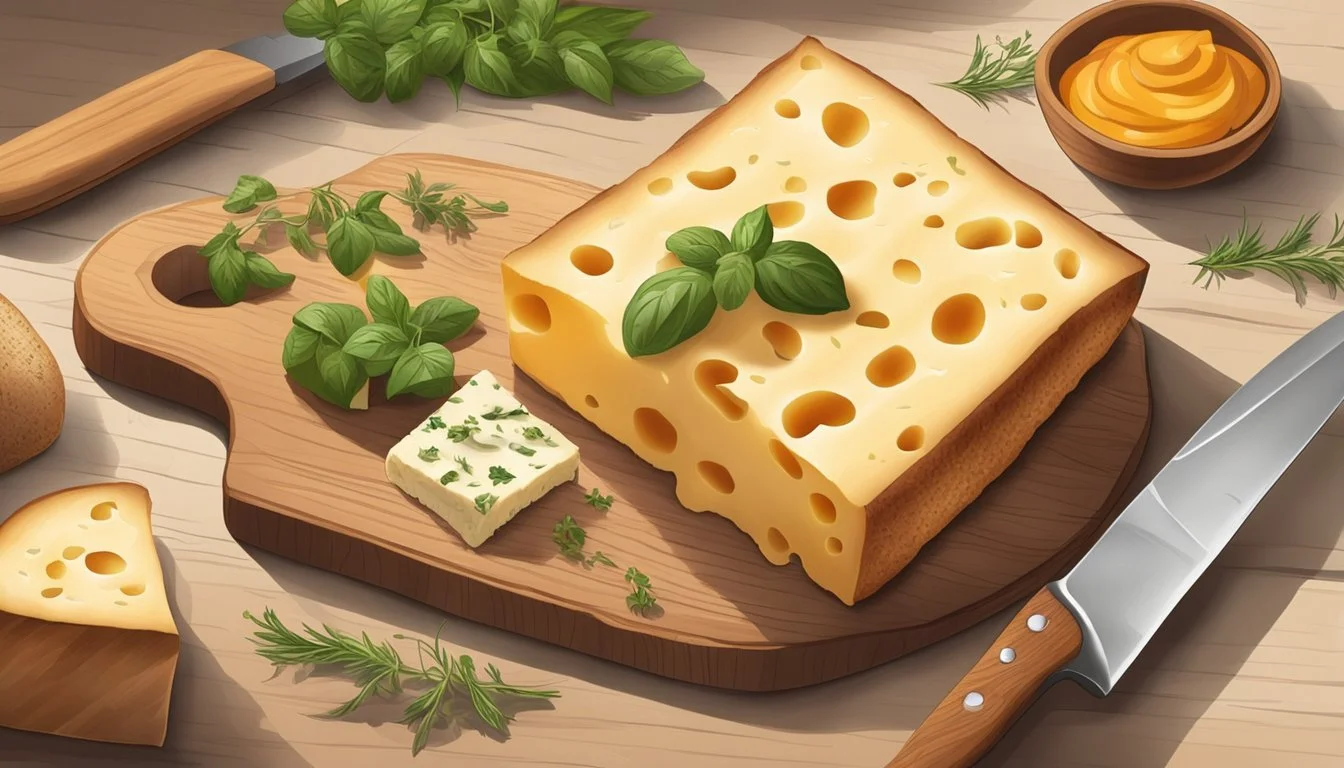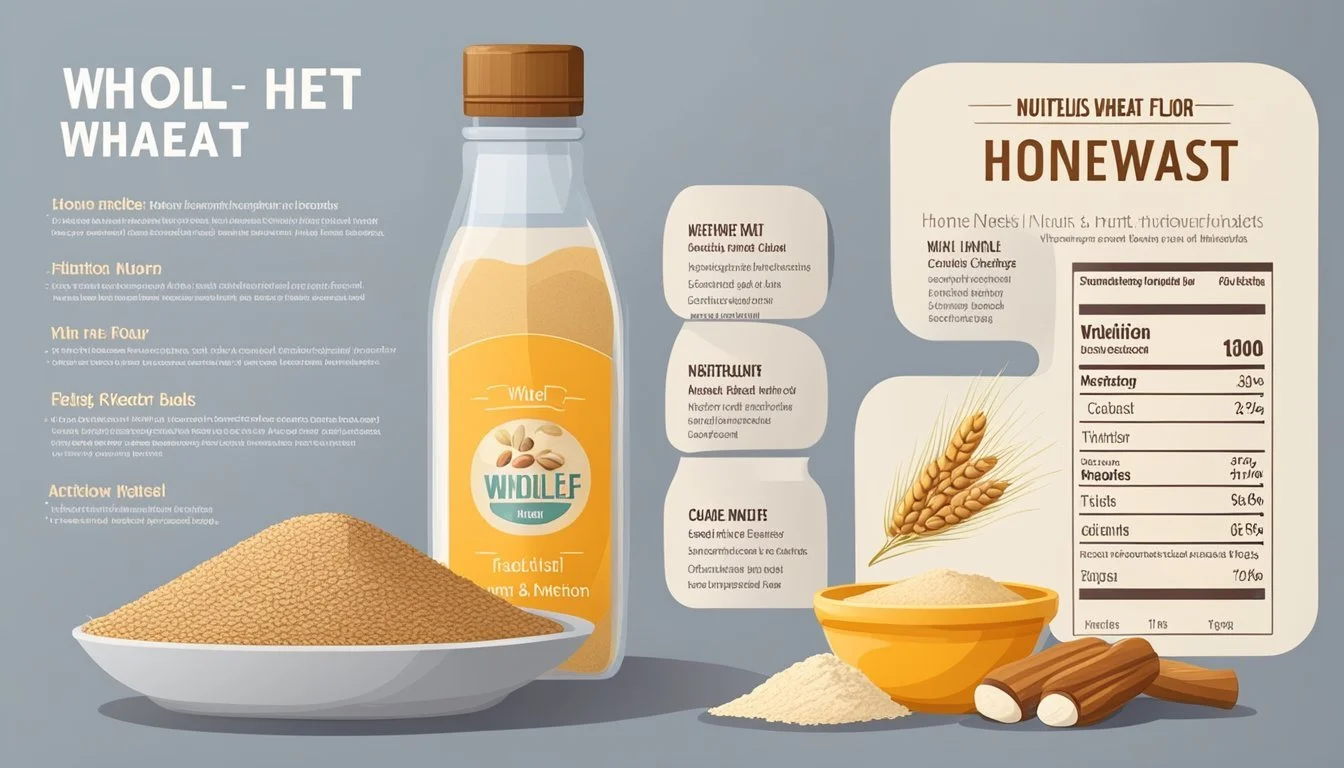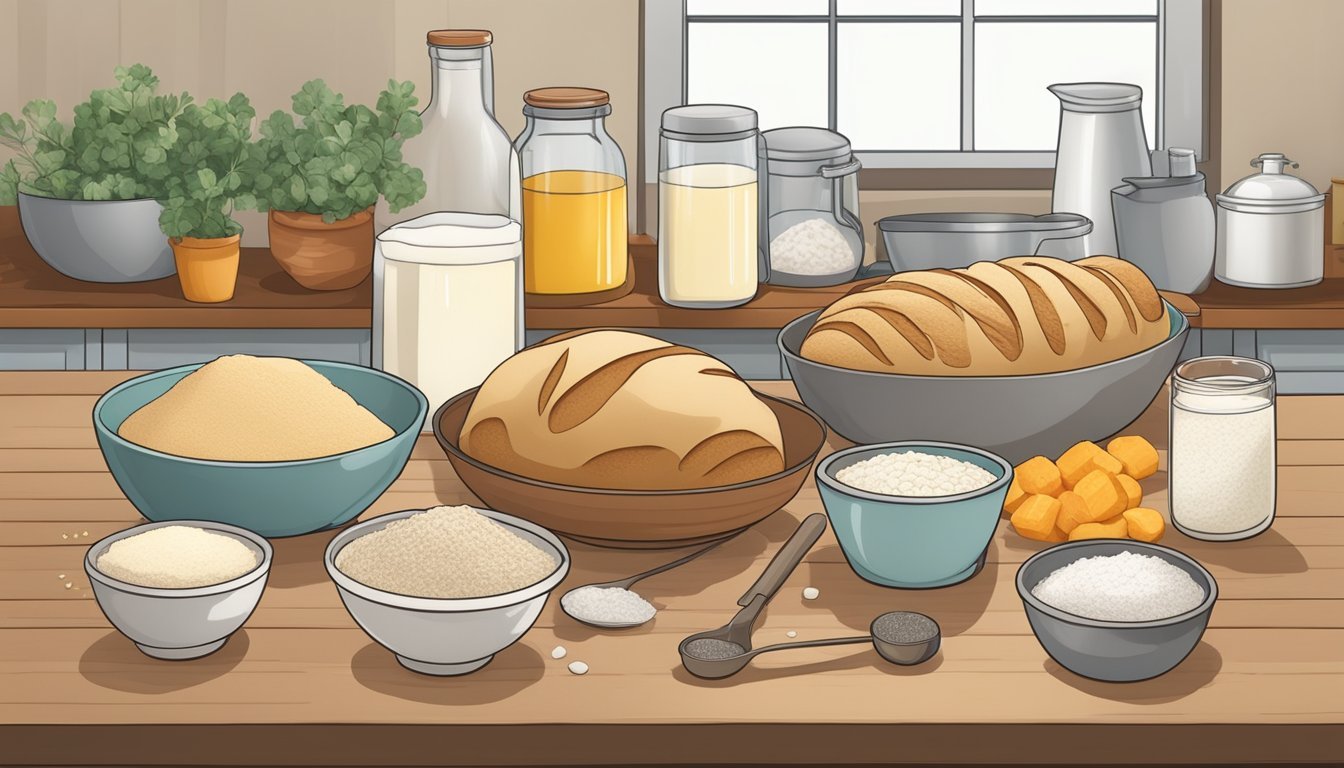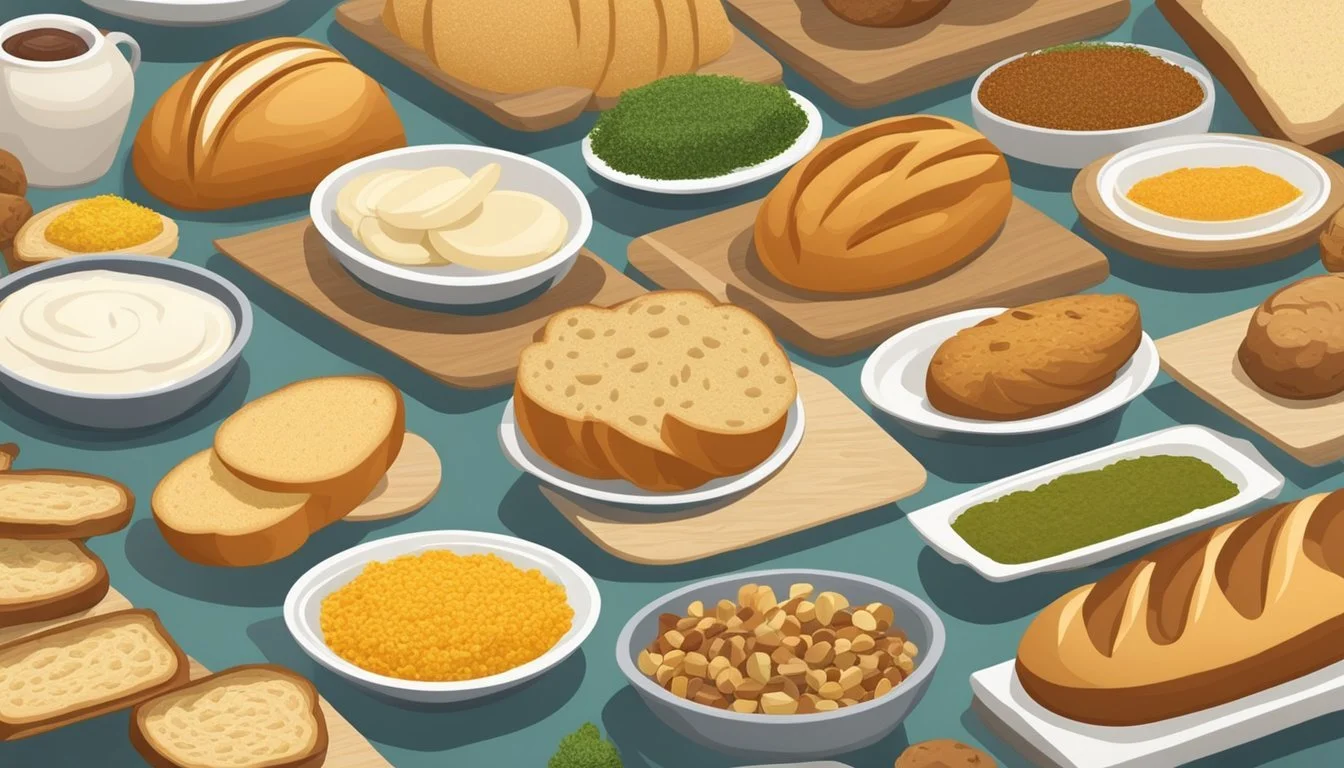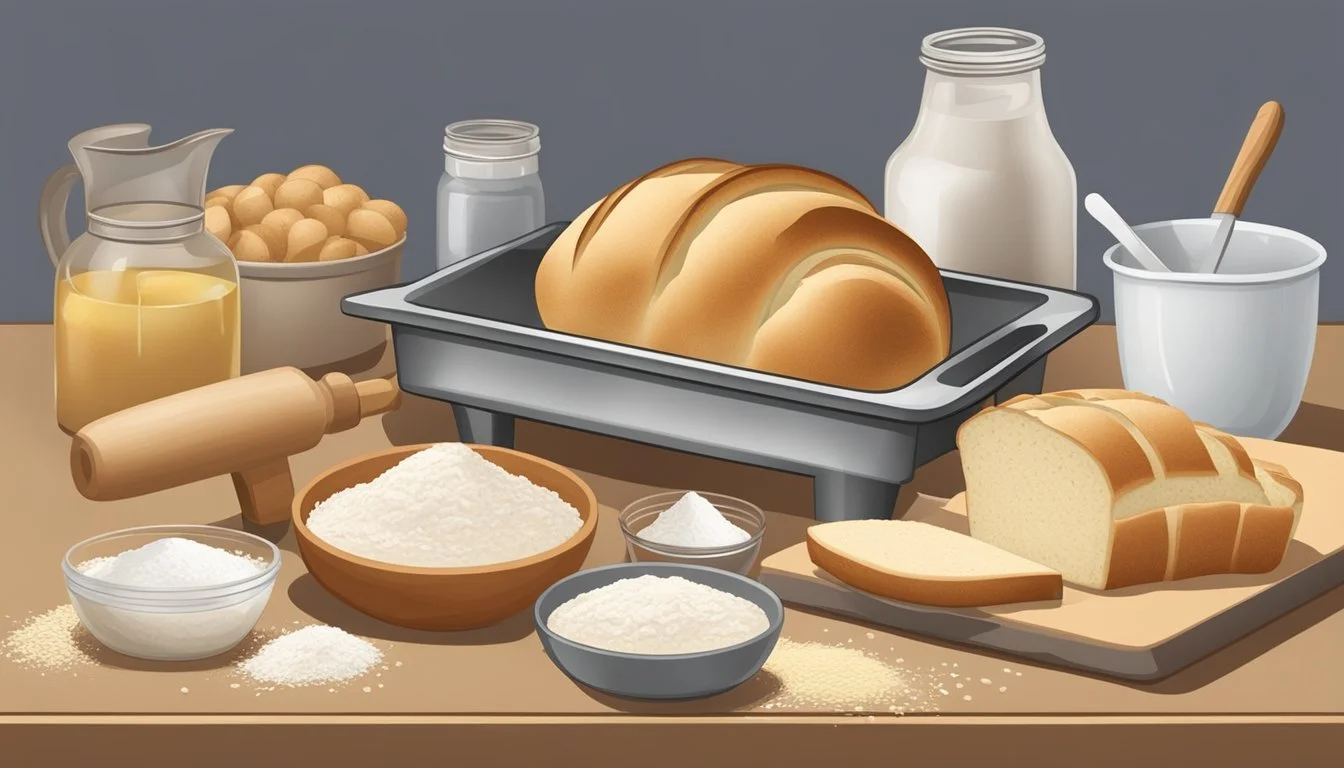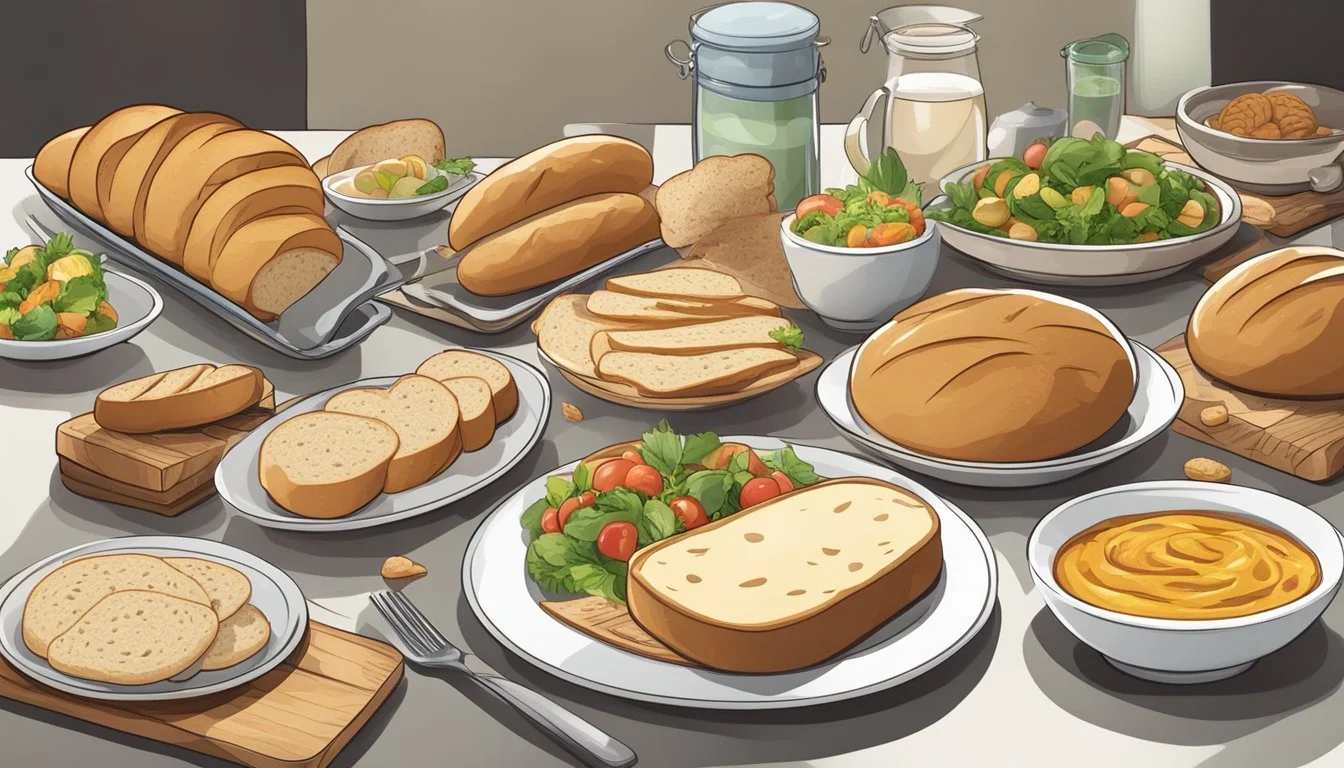Pull-apart Bread Substitutes
Tasty Alternatives for Your Next Gathering
Pull-apart bread, a favorite for its fluffy texture and shared nature, sometimes requires substitutes due to dietary restrictions, ingredient availability, or simply a desire to experiment with new flavors. The concept of pull-apart bread lends itself to versatility, allowing for modifications in almost every aspect of the recipe, from the type of flour used to the variety of fillings added. Home bakers can easily adapt the basic components of traditional recipes to accommodate preferences and needs while still maintaining the integrity of the beloved dish.
Selecting alternative ingredients involves considering the function of the original component in the recipe. For example, replacing dairy milk with a plant-based option like almond or soy milk can cater to vegan or lactose-intolerant diets without sacrificing moisture. Similarly, using gluten-free flour blends allows those with gluten sensitivities to enjoy this communal treat. Innovations in baking also open up possibilities for sweet and savory adaptations of pull-apart bread, with various herbs, spices, and spreads adding unique twists to the classic version.
The key to successful pull-apart bread substitutes lies in understanding the textural and flavor contributions of the replaced ingredients. Substitutions should preserve the tender crumb and rich taste that make pull-apart bread so inviting. By thoughtfully choosing alternatives, bakers can craft delectable variations that stay true to the spirit of the original, ensuring this shared favorite remains as adaptable as it is enjoyable.
Understanding Pull-Apart Bread
Pull-apart bread, also known as tear-and-share bread, is a type of bread pre-portioned for convenience and is characterized by its distinct texture and versatility in ingredients.
History and Origin
Pull-apart bread has its roots in communal eating traditions, where bread is often shared among diners. The concept of a bread that easily separates into individual portions without the need for cutting is a relatively modern culinary innovation, reflecting the shift towards interactive and shared dining experiences.
Characteristics of Pull-Apart Bread
Key characteristics of pull-apart bread include:
Texture: The bread's texture is soft and fluffy with a slightly chewy consistency. Each piece typically has a delicate crust, which is the result of baking the dough pieces together in a loaf pan.
Homemade Quality: Pull-apart bread is often homemade, allowing bakers to infuse various flavors and personalize the bread with additions like herbs, cheese, and garlic.
Popular Types of Pull-Apart Bread
Here are some well-known variations of pull-apart bread:
Savory Options: Breads with ingredients such as garlic, cheese, and herbs.
Sweet Variations: Breads that incorporate sweet components like cinnamon, sugar, and fruit preserves.
The diversity in pull-apart bread types showcases its adaptability and appeal across different tastes and meal courses. Each variety maintains the characteristic ease of sharing that defines pull-apart bread. Whether served as an appetizer, main course accompaniment, or dessert, pull-apart bread remains a favorite for its combination of enticing flavors and communal nature.
Pull-Apart Bread Basics
In crafting a delectable pull-apart bread, choosing the right ingredients and mastering the preparation and assembly techniques are crucial steps to ensure a successful bake.
Ingredients Overview
Yeast: Active dry or instant yeast is essential for bread rising.
Flour: All-purpose flour provides a reliable structure.
Liquids: Water or milk is used to hydrate the dough. Milk enriches the flavor and softens the texture.
Fats: Butter adds flavor and tenderizes the bread.
Seasonings: Sugar and salt are key for taste and yeast fermentation. Garlic, herbs like rosemary and parsley, garlic powder, and olive oil are common for added flavor.
Bread Dough Preparation
Mixing Dry Ingredients: Combine flour, sugar, salt, and yeast in a mixing bowl.
Adding Liquids: Incorporate warm milk or water and melted butter, ensuring the mixture is well-blended but not too wet.
Kneading: Process the mixture into a smooth and elastic dough, which may take several minutes.
First Rise: Allow the dough to rest until it doubles in size, creating a light and airy texture.
Shaping and Assembly Technique
Dividing the Dough: Portion the dough into small, even pieces.
Shaping: Roll individual pieces, coat with seasoned butter or herbed olive oil mixture, and layer strategically in the baking pan.
Second Rise: Let the shaped dough rise again to enhance softness and flavor.
Baking: Bake until golden brown and perform the toothpick test for doneness.
Substitute Ingredients
When making pull-apart bread, individuals with dietary restrictions don’t have to miss out on the deliciousness. Replacing traditional ingredients with gluten-free or dairy-free alternatives can yield a similar texture and taste profile without compromising dietary needs.
Gluten-Free Alternatives
For those who are sensitive to gluten or have celiac disease, regular flour can be substituted with gluten-free flour blends. These blends typically combine various types of flour like rice, potato, and tapioca to mimic the properties of wheat flour. Gluten-free baking also often requires xanthan gum or guar gum to replace the elasticity and binding that gluten provides. Here’s a quick guide to gluten-free flour substitution:
All-Purpose Gluten-Free Flour: Use in a 1:1 ratio for regular all-purpose flour.
Xanthan or Guar Gum: Add ½ teaspoon per cup of gluten-free flour to provide the necessary binding properties.
Dairy Substitutes
Dairy ingredients provide moisture, fat, and richness to pull-apart bread. However, lactose intolerant or vegan individuals can use substitutes without sacrificing flavor. Dairy-free cheese that melts well, such as those made from coconut oil or nuts, can be a good alternative to traditional cheeses like mozzarella or cheddar.
For the wet ingredients, almond milk makes an excellent substitute for dairy milk:
Almond Milk: Replace dairy milk with an equal amount of almond milk.
To replace butter, one can opt for:
Dairy-Free Butter: Available in most grocery stores; can be used in the same quantity as regular butter.
Coconut Oil: A suitable substitute, though it may impart a slight coconut flavor to the bread.
By carefully selecting substitutes, one can create a pull-apart bread that everyone can enjoy, regardless of dietary restrictions.
Alternative Bread Types
Choosing the right bread substitute can significantly enhance a meal, whether one is looking for a different texture, a unique flavor, or has dietary restrictions. This section will explore various bread alternatives, from sourdough variations to cheese-focused options.
Sourdough Variations
Sourdough bread is cherished for its tangy flavor and chewy texture. It is made by fermenting the dough, which not only gives it a distinctive taste but also can make it easier to digest for some people. For those looking for a twist on the classic, considering sourdough variations that incorporate whole grains or seeds can offer additional nutritional benefits and flavors.
Sweet Bread Alternatives
Sweet breads like monkey bread are often sought after for their dessert-like qualities. While traditional monkey bread is a gooey, sweet treat pulled apart by hand, alternatives may include:
Cinnamon swirl bread which provides a similar sweet, spiced flavor profile.
Brioche, a rich and tender bread, often subtly sweetened and used for both savory and sweet applications.
For those seeking less sugar, using naturally sweet ingredients such as sweet potatoes or carrots can be an inventive twist.
Savory Bread Substitutes
For savory notes, there are numerous options:
Garlic bread, usually made with a crusty base such as a baguette, and enhanced with butter, garlic, and often herbs like parsley.
Focaccia, an Italian olive oil-rich bread that can be topped with various herbs, vegetables, and salts, providing a flavorful alternative to pull-apart bread.
These substitutes can bear layers of savory flavors, meeting the needs of those craving a hearty, aromatic bread option.
Cheese-Focused Alternatives
Cheese adds delectable richness to bread alternatives. Options include:
Cheesy breadsticks, incorporating mozzarella or cheddar for a melty texture.
Cheese flatbreads, with shredded mozzarella or parmesan creating a crispy, cheesy crust.
Both options provide a satisfying substitute for those who love cheesy pull-apart bread, retaining that communal, shareable aspect.
Baking Techniques and Tips
Effective baking techniques and precise timing are crucial for creating a successful pull-apart bread, ensuring a perfect texture and flavor profile every time.
Kneading and Rising
When preparing pull-apart bread dough, kneading is a step that should never be skimped on. Proper kneading develops the gluten in the dough, which is necessary for the dough to have elasticity and gas retention. A well-kneaded dough should pass the windowpane test, where a piece of dough can stretch thinly enough to allow light to pass through without tearing. For rising, use a greased loaf pan. The bread should rise until it is just puffy, which can take approximately 30 minutes. Remember, active dry yeast should be dissolved in water first, while instant yeast can be mixed directly with dry ingredients.
Baking Temperature and Time
Preheat the oven to an appropriate temperature before placing the bread inside. Typically, pull-apart bread bakes well at around 350°F (175°C). The baking time may vary, but a common range is 22 to 24 minutes. It is essential to maintain even heat distribution and avoid frequent opening of the oven door to ensure consistent baking.
Bread Type Temperature Time Common Pull-apart Breads 350°F 22-24 mins
Checking Bread Doneness
The bread is done when it has a golden brown crust and sounds hollow when tapped. An instant-read thermometer can also be used to check the internal temperature of the bread, which should reach approximately 190°F (88°C). Allow the bread to cool in the pan for 10 minutes, then transfer it to a wire rack to cool further, promoting even texture and preventing sogginess.
Recipes and Flavor Combinations
This section explores a variety of pull-apart bread recipes, each with a unique combination of flavors and ingredients sure to satisfy a range of taste preferences.
Classic Herb and Garlic
The classic herb and garlic pull-apart bread is both comforting and fragrant. It typically involves layers of dough seasoned with a generous mixture of melted butter, finely minced garlic, and fresh rosemary. The bread is then baked until golden, resulting in a flaky and aromatic treat. Before serving, one can brush the bread with additional garlic butter to intensify the flavor.
Sweet Cinnamon-Sugar Variation
For a sweet twist, the cinnamon-sugar variation is a delightful choice. This dessert-like version calls for a coating of butter followed by a mix of granulated sugar and cinnamon between the bread sections. After baking, the sugar caramelizes, and the cinnamon infuses the bread with its warm, sweet spice. This variation is often enjoyed as a breakfast or brunch (What wine goes well with brunch?) item.
Savory Pesto and Cheese
Pull-apart bread with pesto and cheese incorporates the rich flavors of homemade pesto and freshly grated parmesan cheese. The layers of dough are first slathered with pesto, dotted with bits of cheese, and then baked. The result is a savory bread that offers a burst of basil and cheese in every bite. To enhance the experience, serve the bread warm to appreciate the melted cheese texture.
Cheesy Garlic and Marinara
The cheesy garlic and marinara pull-apart bread is a crowd-pleaser, combining cheese-garlic richness with tangy marinara sauce. The bread is filled with a blend of melted butter flavored with crushed garlic and stuffed with cheese before baking. Once done, the bread can be served with a side of marinara sauce for dipping. The extra-virgin olive oil in the marinara pairs beautifully with the garlic bread's crisp edges and soft center.
Serving and Presentation
When it comes to serving pull-apart bread, the key considerations are choosing the right accompaniments, presenting it effectively at gatherings, and understanding how to store it for later enjoyment. The versatility allows it to shine as an appetizer, side dish, or snack.
Accompaniments and Dipping Sauces
Pull-apart bread can be served with a variety of dips and sauces to enhance its flavor. Bold garlic or herb-infused butters, either salted or unsalted, cater to different palates. For a richer experience, one might prepare a creamy cheese sauce. Consider these options:
Herb Butter: Combine melted unsalted butter with minced garlic and finely chopped herbs.
Cheese Sauce: Melt a mixture of mozzarella and sharp cheddar cheeses with a touch of milk for smoothness.
Party Serving Suggestions
At parties, pull-apart bread is both a delightful treat and an eye-catching centerpiece. Serving it on a large platter allows guests to easily pull and snack. It can be wrapped in foil to retain its warmth. Here's how to present it:
Whole on a Platter: Display the bread in its whole form, allowing guests to enjoy the interactive experience of pulling apart the pieces.
Individual Portions: Pre-pull sections of the bread and arrange on a tray for single servings.
Make-Ahead and Storage
Pull-apart bread can be prepared ahead of time and stored. Cover the bread with plastic wrap and keep it in the fridge if it's to be consumed within a few days. For long-term storage, freezing is an option. Use these guidelines:
Refrigeration: Wrap the bread tightly with plastic wrap or foil; it will stay fresh in the fridge for up to 2-3 days.
Freezing: Pull-apart bread can be frozen for up to a month. Thaw and reheat in the oven for best results.
Health and Nutritional Information
When considering pull-apart bread substitutes, it is important for the reader to note the variations in nutritional content that can impact one's diet. These substitutes offer diverse options when it comes to calories, macronutrients, and vitamins, all of which are essential for a balanced diet.
Caloric and Macronutrient Content
Pull-apart bread is typically high in carbohydrates and calories, but substitutes can offer lower-calorie options with varied macronutrient compositions.
Rye bread: A slice of rye bread, a denser and darker choice, usually contains fewer calories than traditional wheat pull-apart bread and provides a good source of protein and essential fats.
Cauliflower-based options: Items like cauliflower tortillas and flatbreads present a much lower calorie count than regular bread and have reduced carbohydrate content, making them suitable for low-carb diets.
Egg wraps: These wraps, often used in ketogenic diets, mainly consist of protein and healthy fats with minimal carbohydrates.
Dietary Fiber and Vitamins
Fiber and vitamins in bread substitutes can support digestive health and contribute to the overall uptake of nutrients in one's diet.
Fiber: Rye bread typically contains a substantial amount of dietary fiber which aids in maintaining healthy digestion.
Vitamins and Minerals: Some bread substitutes offer additional nutrients:
Vitamin C: Cauliflower options contain vitamin C, which is crucial for immune function.
Minerals: Rye bread includes minerals like potassium and magnesium.
Vitamin A and Calcium: Egg wraps can contribute to the intake of vitamins and minerals, including vitamin A and calcium, though the amounts can be variable.
Table of Nutrients in Bread Substitutes:
Substitute Calories Fat Sodium Potassium Fiber Vitamin A Vitamin C Calcium Protein Rye Bread Moderate Low Low Moderate High Low Low Moderate Moderate Cauliflower Low Low Low Low Low Moderate High Low Low Egg Wraps Low Moderate Low Low Low Moderate Low Moderate High
These substitutes provide not only alternatives to the flavor and texture of traditional bread but also bring distinct health benefits and nutritional properties.
Alternatives to Traditional Baking
Exploring alternatives to traditional oven baking can offer convenient and innovative ways to prepare pull-apart bread, keeping the kitchen cooler and sometimes even saving time.
No-Bake Pull-Apart Options
For those looking to avoid baking altogether, no-bake pull-apart breads can be a revelation. One can create a simple mixture using ingredients like oats, nuts, and dried fruits, then press into a mold or dish to set. A refrigerator or freezer can solidify the ingredients, resulting in an easily shareable and portionable treat without any need for an oven.
Stovetop Methods
Using a stovetop can be just as effective as the oven for making pull-apart bread. A heavy, covered skillet, such as a cast iron pan, can mimic an oven's environment. The dough balls are placed inside and cooked over a low flame, allowing the steam and heat to cook them through. The lid ensures even cooking, and working in batches can produce a sizable amount.
Using Appliances Other Than Oven
Aside from the traditional oven or stovetop, a range of appliances can come to the fore when baking pull-apart bread:
Stand mixers can be utilized not only for preparing the dough with ease but some models also have baking capabilities.
Multipurpose countertop cookers often feature baking settings that can accommodate the requirements for bread.
Convection toasters or air fryer ovens can bake smaller batches efficiently, often using less energy and reducing cooking time.
Adapting for Special Diets
Pull-apart bread can be modified to suit various special dietary requirements. By tweaking ingredients, individuals with restrictions can still enjoy this communal favorite.
Vegetarian and Vegan Adaptations
For vegetarians, the primary concern is avoiding meats. Traditional pull-apart breads, such as those with bacon, safely fit a vegetarian diet if the bacon is excluded. For a vegan version, substitutes are necessary. One can replace butter with plant-based spreads and use vegan cheese instead of traditional dairy cheese. Egg replacements, like flax eggs or commercial vegan egg substitutes, can be used in the dough.
Vegan cheese options: Cashew-based, soy-based, or nutritional yeast for flavor
Egg substitutes: Flax or chia seeds mixed with water, commercial egg replacers
Low-Carb and Keto-Friendly Variations
Individuals following a low-carb or keto diet can modify pull-apart bread by using low-carb flours. Almond flour or coconut flour commonly replaces all-purpose flour to reduce carbs. Furthermore, keto diets require high-fat ingredients which are abundant in a traditional recipe, including butter and cheese.
Low-carb flours: Almond, coconut
Keeping it high-fat: Use regular cheese and butter; avoid low-fat variations
Cultural and Regional Takes
Pull-apart bread, known for its shareable format, finds its place in various cultures with unique interpretations adapting to locality and tradition.
International Pull-Apart Bread Varieties
Brötchenkranz (Germany): This variety involves little buns brushed with butter and embedded with seeds, commonly enjoyed at breakfast.
Jumble Loaf (North America): Characterized by sweet raisin dough, brown sugar, and cinnamon, this bread is layered and baked in a tin to create a chaotic, yet delicious, structure.
Olive Bread (Mediterranean): Enhancing the pull-apart experience, this type incorporates crumbled feta, oregano, and olive oil, capturing the essence of Mediterranean flavors.
These regional recipes reflect the versatility of pull-apart bread within ethnic cuisines, showcasing how each culture infuses its own ingredients and traditions into the simple concept of bread designed to be shared.
Troubleshooting and Common Issues
When preparing pull-apart bread, bakers may encounter challenges related to texture and flavor, yeast-activity, as well as shaping and baking. This section addresses these issues with practical solutions.
Texture and Flavor Problems
One might find that the texture of their pull-apart bread isn't as tender or the flavor isn't as rich as expected. Common causes for such issues include improper flour-to-liquid ratios and inadequate seasoning.
Dough too dense: Ensure the dough is tacky but not overly sticky; adjust with small flour or water increments.
Flavor lacking: Salt should constitute 1.8-2.2% of the total ingredient weight to enhance taste.
Yeast-Related Challenges
Yeast is crucial for the leavening process, but sometimes it doesn't act as intended, leaving the dough flat and heavy.
Inactive yeast: Proof yeast in water between 105°F and 115°F before adding to the dough. If yeast does not foam, it may be expired and must be replaced.
Poor rise: Keep the dough in a warm, draft-free environment. If ambient conditions are too cold, consider placing the bowl in a slightly warmed oven that's turned off or near a heat source.
Shaping and Baking Errors
The aesthetics and cook of pull-apart bread can suffer from missteps in shaping and baking techniques.
Shaping issues: Divide dough into even pieces and shape them uniformly for consistent baking.
Uneven bake: Bake in a preheated oven and check for doneness with a thermometer – an internal temperature of 190°F indicates that the bread is fully baked.
The Science of Bread Baking
In the art of bread making, understanding the fundamental science is essential to achieving the perfect loaf. At the core of this science are chemical reactions and yeast fermentation, which are crucial for dough development and flavor profile.
Chemical Reactions in Baking
Baking bread involves a series of complex chemical changes that convert raw ingredients into a fluffy, edible product. Here are key reactions:
Protein Coagulation: As bread bakes, the proteins (glutenin and gliadin) uncoil and bond, creating gluten networks that give bread its structure.
Starch Gelatinization: Heat causes starch molecules to absorb water, swell, and form a gel, contributing to the bread's crumb.
These reactions are influenced by the presence of sugar, butter, and salt, which affect flavor and texture. For example, sugar not only provides food for yeast but also caramelizes at high temperatures, contributing to the golden-brown crust.
Yeast Fermentation Process
Yeast fermentation is vital for leavening bread. When yeast consumes sugars present in the dough, it produces carbon dioxide (CO2) and alcohol. The CO2 gets trapped in the gluten network, causing the dough to rise and resulting in the light and airy texture of bread. This process can be observed through the following stages:
Mixing: Sugar, milk, and yeast are mixed allowing the yeast to hydrate and activate.
Kneading: Kneading the dough helps develop the gluten matrix to trap fermentation gases.
Proofing: The dough is left to rise as fermentation progresses, which can be influenced by factors such as temperature and humidity.
Through these stages, the performer is yeast, and its effectiveness is paramount in the overall quality of the bread. Science and precision form the backbone of bread baking, where meticulous attention to the behavior of ingredients leads to the creation of aromatic and flavorful pull-apart breads.
Inspiration and Trends
Pull-apart bread is soaring in popularity, offering a combination of appealing textures and flavors that innovate on traditional bread. Creativity in recipes and presentations is fueled by ever-changing consumer preferences and the virality of social media platforms.
Latest Pull-Apart Bread Trends
Savory Selections:
Everything Bagel Pull-Apart Bread: This trendy option infuses the classic everything bagel seasoning into a tear-and-share format, perfect for breakfast or brunch gatherings.
Garlic & Cheese Infusions: A frequent crowd-pleaser is the garlic butter enriched pull-apart bread, oozing with melted cheese and often garnished with fresh herbs for a flavorful twist.
Sweet Sensations:
Loaded Apple & Pecan: Sweet pull-apart breads are taking center stage with ingredients like baked apples and pecans, often finished with a drizzle of icing for dessert appeal.
Decadent Chocolate Varieties: Chocolate-stuffed pull-apart breads are emerging, combining the joy of a pastry with the sharing nature of pull-apart styles.
Social Media-Inspired Creations
Instagram Trends:
Social Savvy Presentations: Instagram has ushered in a heightened aesthetic appeal, with pull-apart bread designs ranging from intricate weaves to simple, elegant toppings that entice followers.
Innovative Flavors: Users are not just sharing photos but also experimenting with unconventional flavor pairings, pushing the boundaries of what pull-apart bread can encompass.
Celebrity and Influencer Contributions:
Endorsements: Celebrities and culinary influencers often spotlight their favorite pull-apart bread creations, influencing baking enthusiasts to recreate these stylish and scrumptious variations.
Community Recipes: Shared recipes become trendy as they are passed along within the Instagram community, inspiring a cycle of new and vibrant pull-apart bread iterations.
Tools and Equipment
When preparing pull-apart bread, having the right tools and equipment can greatly enhance the baking experience and outcome. This section will outline the essentials as well as introduce some advanced gadgets for those looking to elevate their baking process.
Essential Baking Tools
Loaf Pan: A sturdy loaf pan, ideally nonstick, is crucial. For pull-apart bread, one may opt for a Bundt pan to achieve the characteristic shape.
Wooden Spoon: A wooden spoon is essential for mixing dough without overworking it, helping to ensure a tender crumb.
Biscuit Cutter: This tool is handy when a recipe calls for uniform pieces of dough, making the assembly of pull-apart bread more efficient.
Baking Sheet: A half sheet pan lined with parchment paper serves as a surface for preparatory steps or baking, if one is making a free-form loaf.
Advanced Baking Gadgets
Digital Scale: A digital scale offers precise measurements of ingredients, which is key for consistent results.
Dough Scraper: This gadget helps in cleanly dividing the dough and transferring pieces to the baking pan.
Stand Mixer with Dough Hook: For those who bake regularly, a stand mixer with a dough hook attachment facilitates easier and quicker dough preparation.
Accessibility and Convenience
Pull-apart bread is a versatile and engaging dish that can be either purchased ready-made for immediate enjoyment or prepared at home with a few shortcuts to simplify the process.
Store-Bought Pull-Apart Bread Options
For those seeking convenience, several stores offer ready-made pull-apart bread. These options may include varieties like pesto, cinnamon sugar, and everything bagel flavors. These products provide immediate gratification and can serve as a quick side dish or snack. Purchasers should consider:
Presence of preservatives: Ready-made options may contain preservatives to extend shelf life.
Taste and quality: Store-bought varieties might differ in taste compared to homemade versions.
Store Availability Preservatives Taste Comparison Widely available Possible May vary
Simplifying Homemade Pull-Apart Bread
For those who prefer homemade pull-apart bread but are concerned about the time and effort involved, there are strategies to make the process easier:
Pre-made dough: Using canned biscuit dough or pre-made bread dough can significantly reduce preparation time.
Batch preparation: Mixing dry ingredients in advance for multiple batches allows bakers to quickly prepare the dough when desired.
Individuals can add their choice of flavors, such as garlic butter, parmesan, or custom seasoning blends, to personalize the bread. Simplifying the recipe does not mean sacrificing quality, as one can control the ingredients used.
Strategy Time Saving Control Over Ingredients Pre-made dough High Moderate Batch preparation Moderate High
Pairing with Meals
When selecting substitutes for pull-apart bread, consider how the flavors and textures of different options might complement various dishes throughout the day.
Breakfast and Brunch Ideas
For breakfast or brunch, a lighter ciabatta or brioche can be served with eggs and smoked salmon to add a refined touch. Alternatively, scones or flaky biscuits pair well with fruit preserves and clotted cream, offering a delightful balance between savory and sweet.
Eggs and smoked salmon:
Lighter ciabatta
Brioche
Fruit preserves and clotted cream:
Scones
Flaky biscuits
Complements to Soups and Stews
For soups and stews, a crusty baguette offers an excellent crunch and is ideal for dipping. For thicker stews, a hearty rye bread or multigrain loaf provides a robust texture and deep, complementary flavors.
For dipping in soup:
Crusty baguette
For thicker stews:
Hearty rye bread
Multigrain loaf
Dinner and Appetizer Combinations
At dinner, alternatives to pull-apart bread like garlic knots or cheese-filled breadsticks function superbly as appetizers, setting the stage for the main course. For a taco night, homemade corn tortillas add an authentic touch, while Italian focaccia adorned with herbs complements pasta dishes.
Dinner appetizers:
Garlic knots
Cheese-filled breadsticks
Taco night complement:
Homemade corn tortillas
With pasta dishes:
Italian focaccia with herbs
Final Touches and Garnishes
The right garnishes and final touches can transform pull-apart bread from a simple side dish to a culinary masterpiece. Attention to detail in these final steps is crucial for enhancing both the flavor and visual appeal.
Topping Ideas
For a golden and appealing crust, one can brush the pull-apart bread with melted butter mixed with minced garlic before baking. To add texture and a hint of saltiness, a sprinkle of flaky sea salt is effective. For a sweet variation, a drizzle of caramel can provide a balance of sweetness that complements the dough's richness.
Ingredient Method Butter & Garlic Brush on top Flaky Sea Salt Sprinkle before baking Caramel Drizzle after baking
Fresh Herbs and Spices Enhancements
Adding fresh herbs creates both visual and aromatic allure. Finely chopped rosemary or parsley can be sprinkled on top for a fresh, herbaceous note. When it comes to spices, a touch of garlic powder or special spice blends can introduce depth and warmth. Remember, the key is to enhance, not overpower, the bread's natural flavors.
Fresh Herbs: Parsley, Rosemary (finely chopped and sprinkled)
Spices: Garlic Powder (sprinkled), Custom Spice Blends (lightly dusted)
Using these garnishes can significantly elevate the pull-apart bread, making it not only a delectable accompaniment but also a standout dish in its own right.

